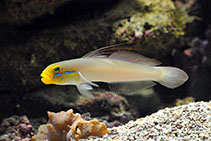| Family: |
Gobiidae (Gobies), subfamily: Gobiinae |
| Max. size: |
18 cm TL (male/unsexed); max. reported age: 1 years |
| Environment: |
reef-associated; marine; depth range 1 - 25 m |
| Distribution: |
Indo-Pacific: East Africa to Tuamoto Islands, north to the Ryukyu Islands, south to Sydney, Australia, including Lord Howe Island. |
| Diagnosis: |
Dorsal spines (total): 7-7; Dorsal soft rays (total): 17-19; Anal spines: 1-1; Anal soft rays: 16-19. Characterized by pale grey body color; yellowish head; bluish curved bar from below eye to opercle (Ref. 2798); thin bluish white bar on pectoral fin base; second to fourth dorsal spines prolonged as filaments in fish larger than about 4.5 cm; rounded caudal fin, longer than head; longitudinal scale series 101-126; ctenoid body scales, becoming cycloid anteriorly below first dorsal fin; head or midline of nape without scales; side of nape with scales extending forward to above or slightly before middle of opercle; fully scaled pectoral fin base and prepelvic area in adult; depth of body 4.5-5.1 in SL (Ref. 90102). |
| Biology: |
Common in clear outer lagoon and seaward reefs, over hard bottoms as well as over sand and rubble. Typical along reef-crests in depths of 1-6 m, but has also been collected from depths of 24 m. Usually seen in pairs, hovering near their burrow. Monogamous (Ref. 52884, 48637). Feeds on small benthic invertebrates, fishes, and fish eggs by sifting mouthfuls of sand. |
| IUCN Red List Status: |
Least Concern (LC); Date assessed: 20 June 2017 Ref. (130435)
|
| Threat to humans: |
harmless |
Source and more info: www.fishbase.org. For personal, classroom, and other internal use only. Not for publication.
